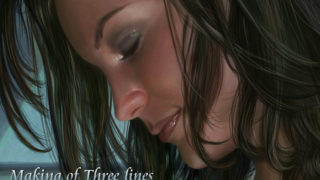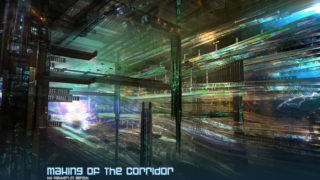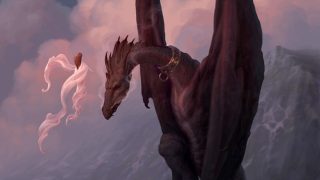
Making of Say Cheese
In this image, artist make the dirty flooded water bathroom and fish tries to survive there in between of leaked pipes.
IntroductionI was so inspired with water tanks in childhood. Whenever I’ve visit fisheries and aquariums, I always found some attraction towards one tank which was dirtier and poor a fish try to accommodate in that. I’ve always spend time to observe water movement and its whirl effects. So I approached to make cool dirty flooded water bathroom, and fish tries to survive there in between of leaked water pipes. Even leaked pipe blows air into water which makes sweetie bubbles. The idea clicked me once and started scribbles for making ahead. I had very much decided to make it like ‘Portrait photograph’ kind of wall mounting image, so I was sure at all concept visualization and idea making from first. Setting Foundation first: before any further move, I always prefer to make little production scratch chart for my guideline, which can help me to focus in between my personal work and office work’s deadly deadline as shown in fig. below |
 |
|
Usually I’m spending 2-3 hrs for my personal work daily. That’s why I assumed to spend almost 2 weeks for ‘Say cheese!!’ artwork, then I started to make rough list of production stages which I’ve thought to make out whole artwork in estimated time and with most perfection. After rough calculation, I’d started to make concept drawings and thought to add lots of stuffs into it. |
 |
|
I was about to add more than two fishes at a time but, it was giving scene much complexity and unbalance ness. I wanted to spend little more time for concept design to make it clean clear idea. Concept gives me very bright appealing for composition and POV. Every photographer’s most challenge is to show intentional (Focused) content which they have clicked for. So, I was trying to be precise for a fine layout setup where I can apply rules of actual photography senses. After rough conceptualization, I’d started to make out rough asset list of props, BG elements and rigged characters against ‘production scratch guideline’. ReferencesAfter conceptualization, I really needed real references for water effects, bubbles, gravels, dirt tiles and especially for fish. I gathered all possible references from net and even reused from my references library. I founded very good references for fish eyes, and it attracted me lot to experiment onto. Well most key role for any character artwork is to learn its whole anatomy first. I checked out fish anatomy for better to make modeling and texturing. |
 |
SculptingWell, that’s really ‘full of fun’ stage; just we need to be aware of some pre-requites steps before get into Z-Brush package. Such as clean topology, clean UVs (if you want to use any map), equal space of quads, lesser tries. I’d decided to put full details as much as possible on Fish in Maya only. I’d started sculpting with ‘Standard brush’ and ‘Inflate brush’ to catch up basic details on 1st level of subdivision. I was keep going towards more details, particularly on fins, gill cover, anal fin, soft dorsal fin and caudal fin area within 2nd and 3rd level of subdivision. |
 |
 |
|
I usually get shuffle from each level alternatively. When I was satisfied with appropriate details, then I took fish sculpting for final details like creases, spots, and fish skin pattern around at last subdivision level. Even I’d used layers option for more details like skin pattern with help of alpha brush. After happy sculpting, I’d decided to use masking with cavity and enhanced details. Now time was for posing, so I took it to lowest level and exported to Maya and rigged (Last level, rigged one) then again imported back to Z-Brush. I’d decided camera angle so, I didn’t need to concentrate on asymmetrical shape. |
 |
Texturing and ShadingTexturing and shading is one of the important stages through out whole artwork look and feel depended. I assumed major objects would be shaded with procedural shaders. So, I used very basic single switch node for gravels and I’d used 3 little scripts for randomization. Assigned user defined attribute “vcoord” to n selected objects using script.
|
 |
|
For pipes, I was so inspired from old copper and mossy effect. I felt little difficulties when I was rendering pipe shader; I found some strange dull ness in over all color because of “proxy box” caustics photons. Then I solved it with tweaking in base color and transparency in layered texture nodes.As far as bubbles concerned, I made two different shaders for surface bubbles and water bubbles. So, I used different MR dielectric and DGS materials for bubbles. I found problem at water droplets on tiles were highly intensive glow because of key photonic light was linked to it. Refraction and reflection was tricky to handle. There are basic properties for various water density, bubbles and droplets properties. |
 |
| I used zbrush for fish and tiles texturing, especially I’d used ZApp-link plug-in for easy texturing, which can be interlinked with photoshop and zbrush visa versa. Great package from ZBrush!! |
 |
| I made specular, reflection, all three skin layer maps from ZBrush for MR SSS shader in Maya. I’d noticed shiny glossiness in fish skin, so I need to make glossy map which was really effective enough. Even SSS shader’s specular attribute has quite detailed options to generate nearly real skin as per Figures below |
 |
 |
Lighting and RenderingI used MR and Maya procedural shaders for whole artwork, which gave me very nice result. Id used basic 3 lights setup (photonic key, fill and rim light). Id used key photonic light for whole Layout and other 2 lights were linked just for fish individually because of Back scatter effect. Id used GI photons for better result to the scene. Because of mental rays dielectric shader and DGS refracted and reflection values, I had used caustics photons also. I was exited with double bounced shadow layer when light reflected through main photonic Light. It gave me real water shadow effect through. |
 |
|
I made proxy/dummy box under water level till floor with refracted glass, transparent shader assigned on it. It was just for refracted effect to water from straight front. Over all i tried to make Light setup is so formal and simple but, somewhere was little tricky. I was facing challenge at rendering occlusion pass, where refraction appears at under water portion specially. But, simple solution was to assign manually overrides at each property of light and shaders, i.e., in occlusion pass; I made AO shader, proxy box has same refracted shader but, I’d assigned AO shader to all other objects apart from ‘proxy box’. |
 |
| I always prefer self review first! After almost final rendered image, I did self correction and review of an image. Self review is much appropriate for current stage before publish image for presentation. According to self review I found some minor creative corrections and changes. So, I rather preferred to be back on texturing and layout stage. I rapidly changed in layout according to review then, it came up with very straight appealing composition. Production can be suffered if you found some problems, which can be technical or creative after rendering passes. So, reviews+ correction stages are most reliable and accurate for any production | |
 |
 |
CompositionAfter rendering all passes separately, I took all of them into photoshop and started to tweak values according to subject. I rather choose photoshop for compositing because I wanted to make it like standalone photo frame kind of image. In whole colored scene, threshold color histogram was quite on proper curve and balance so; it was healthy to convert it to Black and white without missing minor details. I was really imagined about simple monochromatic mood but, little curiosity to achieve real fish skin and water effect. Later Id added little paint over to highlight shinier over all. I took some basic render passes according to present various nesses in picture. |
|
 |
|
 |
|
Related linksEmail: vaibhavshah1982@gmail.com Website: http://vaibhavshah1982.blogspot.com/ |
|














